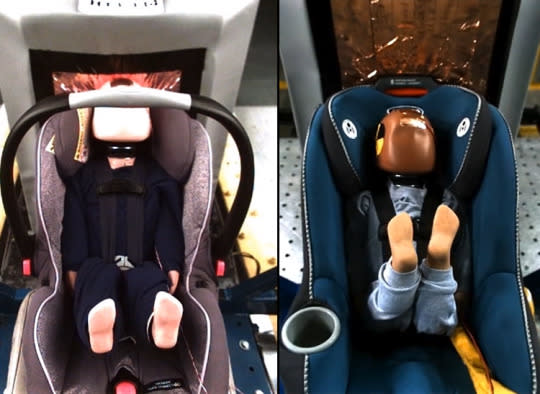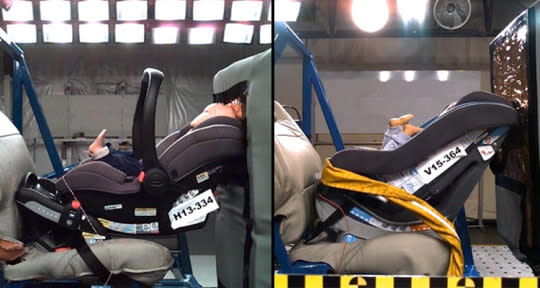Why You Should Buy a Convertible Car Seat Sooner Rather Than Later

You might be tempted to wait to buy a convertible child seat for your infant, if for no other reason than the convenience of using the detachable carrier. But the results of our recent tests—in addition to new safety guidelines and state laws—should encourage you to buy a convertible car seat by the time your child celebrates his first birthday.
STORY: 5 Top-Rated Convertible Car Seats

What We Found
The recent release of Ratings for convertible child seats marks the second group to be rated using Consumer Reports’ new test protocol for child car seats. Ratings for rear-facing only/infant seats already reflect their performance in the new test.
One of the main objectives in developing the new test was to better differentiate the ability of a variety of child seats to protect a child’s head. Head injuries to children in crashes are a significant concern for Consumer Reports. Other crash tests, including the government standards, do not measure what happens when a child comes into contact with another part of the vehicle. To that end, a key component of our test is the addition of a surface that simulates the interaction the child seat would have with the front seatback in an actual vehicle crash.
It was this interaction that provided some key insights into the potential safety benefits of convertible seats for rear-facing kids. In previous testing of a group of infant seats that include a detachable carrier, we found that the 22-pound dummy, representing an average 12-month-old child, suffered a head strike against the simulated front seatback with 16 of the 30 tested models (53 percent).
In our most recent tests of rear-facing convertible models with that same dummy, we found that the dummy’s head contacted the front seatback with only one of the 25 convertible models we tested (4 percent). The longer shells and shape of the convertible seats provided additional space between the dummy’s head and the simulated seatback preventing direct contact of the head.

What Do Those Results That Mean to You?
Height matters. Many infant and rear-facing-only seats have weight limits between 30 and 35 pounds, so you may think those seats are adequate until your child reaches that weight—at about 2 years of age. However, your child will more likely grow out of those seats, height-wise, before reaching those weight limits. See the Types and Timeline in our car seats buying guide.
You’ll need one anyway. In order to keep your kid rear-facing until her second birthday, you’ll still have to buy a convertible model. Not only do Consumer Reports’ child-seat experts encourage this strategy, but the American Academy of Pediatrics recommends parents keep children rear-facing until the age of 2. New laws in California, New Jersey, and Oklahoma require that all children under the age of two be in a rear-facing child seat.
Best for your kids. These new results show that for kids around age 1 that convertible seats may provide some additional protection over an infant seat in protecting a child’s head.
Safety outweighs inconveniences. Yes, moving to a fixed rear-facing seat means you lose the convenience and portability of the infant carrier. But your growing baby’s weight, combined with the portable seat, become heavy to lug around, negating the seat’s appeal. Plus, the Journal of Pediatrics found that it’s dangerous to let a baby sleep in an infant seat when outside of the car. So don’t worry about waking your baby when taking him out of a rear-facing seat. It’s the safer option.
Make the switch now. To take advantage of a convertible seat’s added potential for head protection, we advise that if your child has not already outgrown her infant seat (many will), transition your child to a rear-facing convertible seat no later than age 1.
The good thing is that this new advice doesn’t change the number of seats you’ll need. It simply suggests making a transition that you already needed to make, sooner rather than later. —Jen Stockburger
(Photo: NHTSA)
More from Consumer Reports:
5 least reliable cars from Consumer Reports’ survey
Best cars for making it to 200,000 miles
Consumer Reports has no relationship with any advertisers on this website. Copyright © 2006-2015 Consumers Union of U.S.

